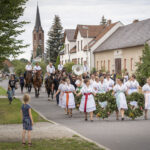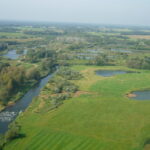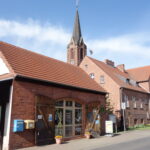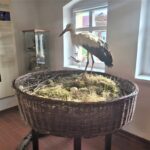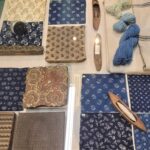Dissen/ Dešno, Brandenburg, Germany
The village of Dissen, called Dešno in Sorbian, with its 680 inhabitants is located in the South of Brandenburg, around 10 kilometers from the city Cottbus. It is part of the collective municipality Burg. With its around ten stork nests and strong ties to the Sorbian-Wendish culture and tradition, it rightfully positions itself as “village of storks and museums”.
Immediately adjacent to Dissen is the Spree floodplain, which has been renatured over a length of eleven kilometers by the mining company Vattenfall since 2006 as a compensatory measure for an opencast mining area near Cottbus. Today this natural area is an important recreational area for the residents of the region, it covers an area of over 400 hectares. In addition, as part of the renaturation project, the aurochs and water buffalo were established by Spreeaue GmbH as a sign of sustainable agriculture. Various projects were developed in cooperation with the local population and the operating company of the opencast mine, such as circular hiking trails, a playground, a willow tunnel and the vista hill “Teufelsberg”, from which you can enjoy a unique view of this nature reserve.
For the community and the village of Dissen, the year 1989 with the political change represents a transition to a time in which new challenges arose and new topics gained importance. At the time of political change, the village had fewer than 500 inhabitants, the infrastructure was dilapidated, and little money was invested in repairing the old buildings. In addition, the required building materials were scarce. However, it was an opportunity for the village that the old building structure was preserved after reunification, although it was not uncommon for it to be in poor condition. The image of the village is still characterized today by the four-sided courtyards, the so-called “Torhaushöfe”. The strong identification of the village with its history, its culture and its Sorbian-Wendish tradition is also the reason for its concern to use and preserve the existing building stock. In this context, the repair of the four-sided courtyard “Tylcyc” in the center of the village of Dissen, which today serves as a fire station, should be mentioned.
In recent years, Dissen has been characterized above all by the implementation of new and innovative ideas, which are supported by personal initiative and a sense of community as well as a focus on areas that have played a subordinate role in the past. Today they characterize the village.
A central feature of the village is that it belongs to the traditional settlement area of the Sorbs and Wends. It is still very important today for municipal leaders and volunteers to preserve and cultivate the Sorbian-Wendish traditions. On the one hand, the history of the Sorbian-Wendish culture in the village is represented by the local history museum where visitors can explore the historical way of life of the Sorbian-Wendish farmers. The local history museum also makes an important contribution to the preservation of the material and immaterial cultural heritage of the Sorbs and Wends and demonstrates the strong identification of the Dissener with this culture, something that is also reflected in the maintenance of customs. In the immediate vicinity of the local history museum and the church you will find the open-air museum “Stary lud – The old folk” for which five pit houses were built, which provide an insight into the Slavic-influenced Middle Ages. With these facilities, the municipality has not only succeeded in making its own history tangible, but at the same time it has also created a tourist attraction that is unique in the region. Furthermore, there are opportunities school classes – and thus for children and young people – to learn about the past.
The unique Sorbian-Wendish customs are an integral part of village life and therefore the preservation of the language as a living sign is a major concern. Measures such as the introduction of bilingual boundary signs and information boards are therefore formative, all the more so that around 100 private farm owners have also attached their farm name signs in Wendish.
The active and intact club life is essential for the community. The rather low population is also seen as an opportunity and not just as an obstacle: an intact, almost family-like village community has formed over the last few years. In this context, the shooting club “Briesen e.V.” deserves special mention, whose members have completely renovated an old cowshed and repaired it as the new club domicile. Overall, Dissen is characterized by great civic commitment, which is particularly visible and noticeable within the clubs. Aware of the central role of these associations, the municipality provides premises for their activities, such as the already mentioned “Tylcyc” courtyard for the fire brigade, a youth room and a soccer field.
Today, Dissen is an attractive place to live in the immediate vicinity of the city of Cottbus, which is why some smaller new development areas have been designated in recent years, but the preservation of the village building stock is the focus. This is particularly reflected in the design statute set in 2014.
The positioning of Dissen as a stork and museum village has been successfully implemented in recent years. The strengths of the village certainly lie in the intact village community, which is committed to preserving the Sorbian-Wendish traditions and is constantly developing new ideas. At the same time, projects aimed at an ecological and economic future are implemented. The unique natural landscape of the Spreeaue with its existing and ever growing infrastructure offers great opportunities for tourism and is an essential guarantee for the high quality of life in the village.
Evaluated: 2022

